Chapter 16
Bloody Relic of Belleau Wood
Albertus W. Catlin
By Gretchen Winterer, Uniforms and Heraldry Curator
Featured artifacts: Small Box Respirator, Gas Mask Bag (1991.303.1b); and Medal, Purple Heart (2016.185.18)
Give ’em hell, boys!
~ Brigadier General Albertus W. Catlin[1]

Col Albertus Catlin in the early 1900s.
Library of Congress.
World War I had been raging for three years in Europe by the time the United States entered the conflict in April 1917. Russia’s withdraw from the war in March 1918 allowed Germany to reallocate forces to the western front, aiming to annihilate the British and French troops fighting there. The American Expeditionary Forces (AEF), which included the 4th Brigade of the U.S. Marine Corps, began arriving in France in June 1917. The 4th Brigade was composed of the 5th Marine Regiment (which had arrived alongside the first U.S. troops in June 1917), the 6th Marine Regiment, and the 6th Machine Gun Battalion (both of which arrived in February 1918). The Marines moved from Verdun to Chaumont en Vexin, and then to the Château-Thierry sector. By the beginning of June 1918, the bolstered German offensive pushed the British and French back to within 75 kilometers of Paris and forced the AEF to the front lines. In a calculated offensive attack, the Marines were ordered to capture Bois de Belleau (Belleau Wood) from the Germans. After 31 days of constant fighting, the Marines successfully pushed the Germans back. Following several more battles, including those at Saint-Mihiel, Blanc Mont, and the Argonne Forest, the Germans agreed to an armistice in November 1918, thereby ending the war.[2]
The Battle of Belleau Wood (1–26 June 1918) was a major turning point in the war and a pivotal moment for the Marine Corps. On the first day of the battle, more than 1,000 Marines were killed or wounded, which was a higher casualty number than the Corps had experienced across its entire existence. But by the war’s end, the Marine Corps has solidified its evolvement from seagoing Marines to a global force in readiness on land and sea.
Legends were born at Belleau Wood. Four future Commandants of the Marine Corps participated in the battle: Wendell C. Neville, Thomas Holcomb, Clifton B. Cates, and Lemuel C. Shepherd Jr., Gunnery Sergeant Daniel J. Daly, and Colonel Albertus W. Catlin also played major roles in the U.S. victory. Catlin commanded the 6th Marines; at 49 years old, he was already a seasoned Marine with a long career under his belt.

MajGen Omar Bundy (left) with Col Albertus Catlin near Sommedieue, France, in April 1918.
U.S. Army War College, Historical Section.
Albertus Wright Catlin was born in New York on 1 December 1868. He attended the U.S. Naval Academy in Annapolis, Maryland, where he was the captain of the football team for three years before graduating in 1890. Catlin completed his required sea duty aboard the protected cruiser USS Charleston (C 2) and commissioned into the Marine Corps as a second lieutenant in 1892. He finished first in his class at the Marine Corps School of Application in 1893, was promoted to first lieutenant, and spent time aboard the protected cruiser USS Cincinnati (C 7). Catlin was then transferred to the second-class battleship USS Maine (1895) and commanded the ship’s Marine detachment until 1898, when an explosion aboard caused it to sink in Havana Harbor, Cuba. Catlin survived, but 261 of the ship’s 355 crewmembers were killed.[3]

A U.S. Navy diving crew at work on the wreck of the USS Maine (1895) in 1898, seen from aft looking forward.
Naval History and Heritage Command.
Catlin briefly served in the Spanish-American War (1898), during which he participated in the blockade of Santiago de Cuba before being promoted to captain and assigned to the Marine barracks at Port Royal, South Carolina. During the early 1900s, Catlin served in the Philippines, the Dominican Republic, and Cuba. In 1914, while serving aboard the battleship USS Wyoming (BB 32), Catlin earned the Medal of Honor for leading the provisional 3d Marine Regiment, comprised of Marine ship detachments from the U.S. Atlantic Fleet, into Veracruz, Mexico, and capturing the city. His citation reads: “For distinguished conduct in battle, engagement of Vera Cruz, 22 April 1914. Eminent and conspicuous in command of his battalion, Maj. Catlin exhibited courage and skill in leading his men through the action of the 22d and in the final occupation of the city.”[4] Veracruz was the first action in which Marine officers were eligible to receive the United States’ highest military award.
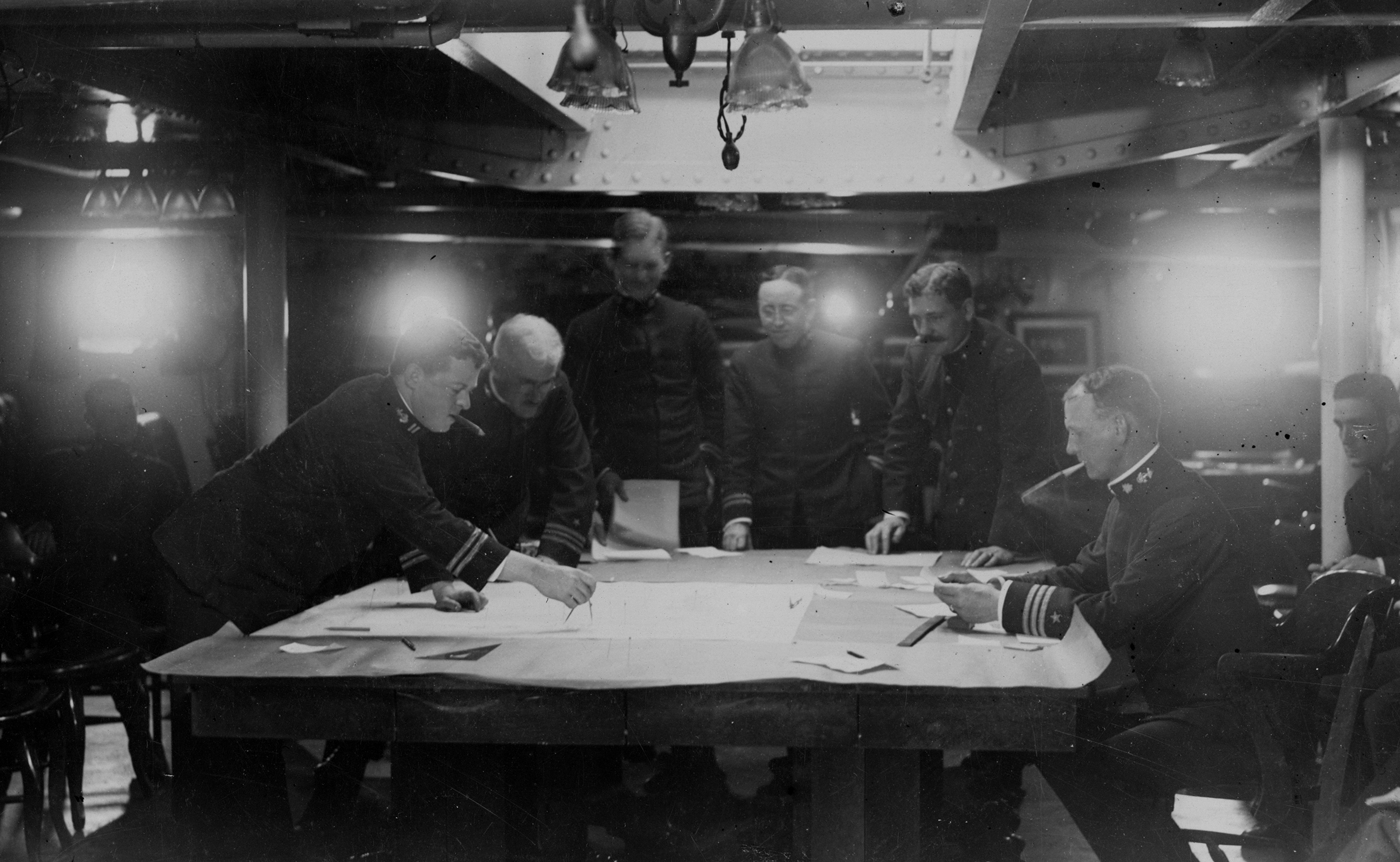
The staff of RAdm Charles J. Badger, commander in chief, U.S. Atlantic Fleet, in a planning session on board the USS Wyoming (BB 32) in 1913. Those present around the table are, from left to right: Lt Gardner L. Caskey, USN; LtCdr Walton R. Sexton, USN; LtCdr Frank R. McCrary, USN; Lt Stanford C. Hooper, USN; Maj Albertus W. Catlin, USMC; and Cdr Carl T. Vogelgesang, USN.
Naval History and Heritage Command.
Catlin was promoted to lieutenant colonel in October 1915 and colonel in August 1916. He was commanding the Marine Training Camp at Quantico, Virginia, when he was assigned to lead the 6th Marine Regiment in France. On 6 June 1918 at Belleau Wood, Catlin oversaw the Marines’ advance across the wheat field and into the woods. As the Marines prepared to move forward, he offered four words of encouragement: “Give ’em hell, boys!”[5] That evening, Catlin was struck by a German sniper. “It felt exactly as though someone had struck me heavily with a sledge,” he wrote in his memoir. “It swung me clear around and toppled me over on the ground. When I tried to get up, I found that my right side was paralyzed.”[6] The bullet, fired from 600 yards away, penetrated Catlin’s gas mask, pierced through his right lung and exited his back. He recalled, “I suffered but little pain and I never for a moment lost consciousness. Nor did any thought of death occur to me. . . . I was merely annoyed at my inability to move and carry on.”[7] French Army captain Tribot Laspierre pulled Catlin into a trench and placed the colonel’s damaged gas mask over his face while the pair waited for the heavy artillery fire and gas shells to subside. After evacuation nearly two hours later, the mask was cut off of Catlin and salvaged by Laspierre. Catlin survived his wound and was sent back to the United States on 22 July 1918.[8]
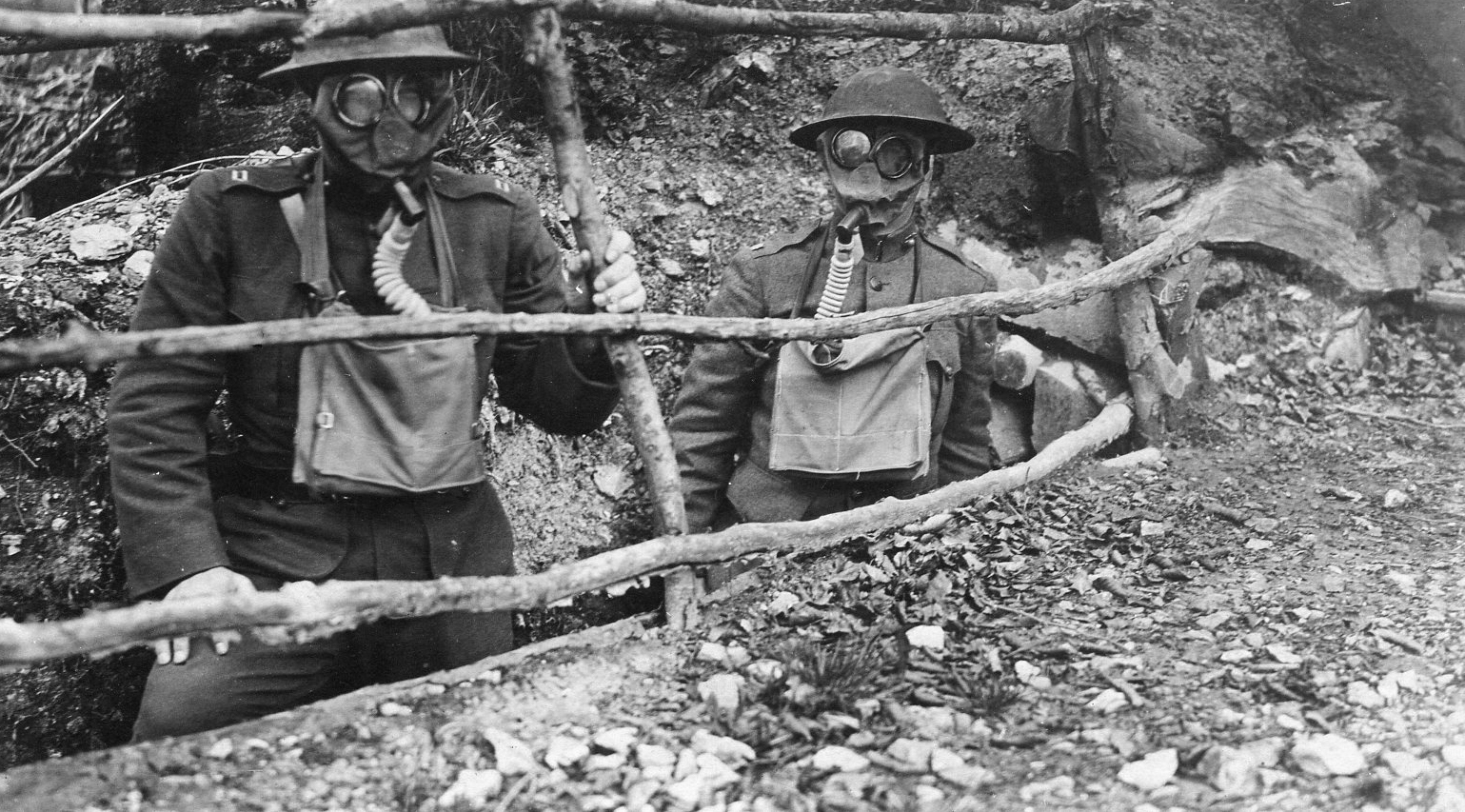
Wearing gas masks at Verdun, France, 1918.
Marine Corps History Division.
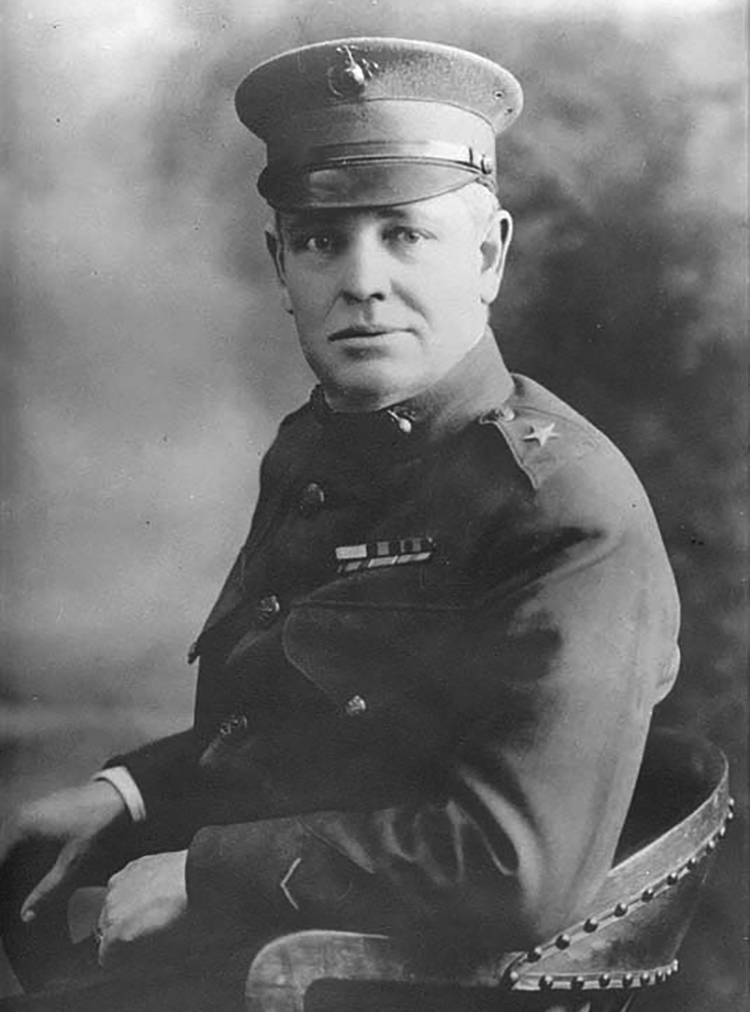
BGen Albertus W. Catlin, photographed ca. 1919.
Naval History and Heritage Command.
For his service in France, Catlin received the Croix de Guerre with palm. During his recovery at Headquarters Marine Corps, he was promoted to brigadier general, and his last assignment was command of the 1st Marine Brigade in Haiti before his retirement in December 1919. Catlin’s remarkable Marine Corps career spanned nearly 30 years. He spent his final years battling continued illness from his combat wound until his death on 31 May 1933. He is buried in Arlington National Cemetery.
When the United States entered World War I, its military forces were wildly unprepared for chemical warfare, unlike their English and French comrades. AEF forces began using the French M2 gas mask, though, by design, it was only adequate to protect against light chemical attacks. In 1918, AEF forces began to use the British Small Box Respirator (SBR), which fit snug over one’s face with eyepieces, a nose clamp, and a mouthpiece. The hose attached to the mouthpiece on one end and a box filter on the other. The filter fit inside a canvas-style bag with an adjustable strap.[9] Eventually, the United States developed its own gas mask, the Corrected English Small Box Respirator, or M1917, which was styled remarkably similarly to the English SBR, with only a few minor changes.[10]
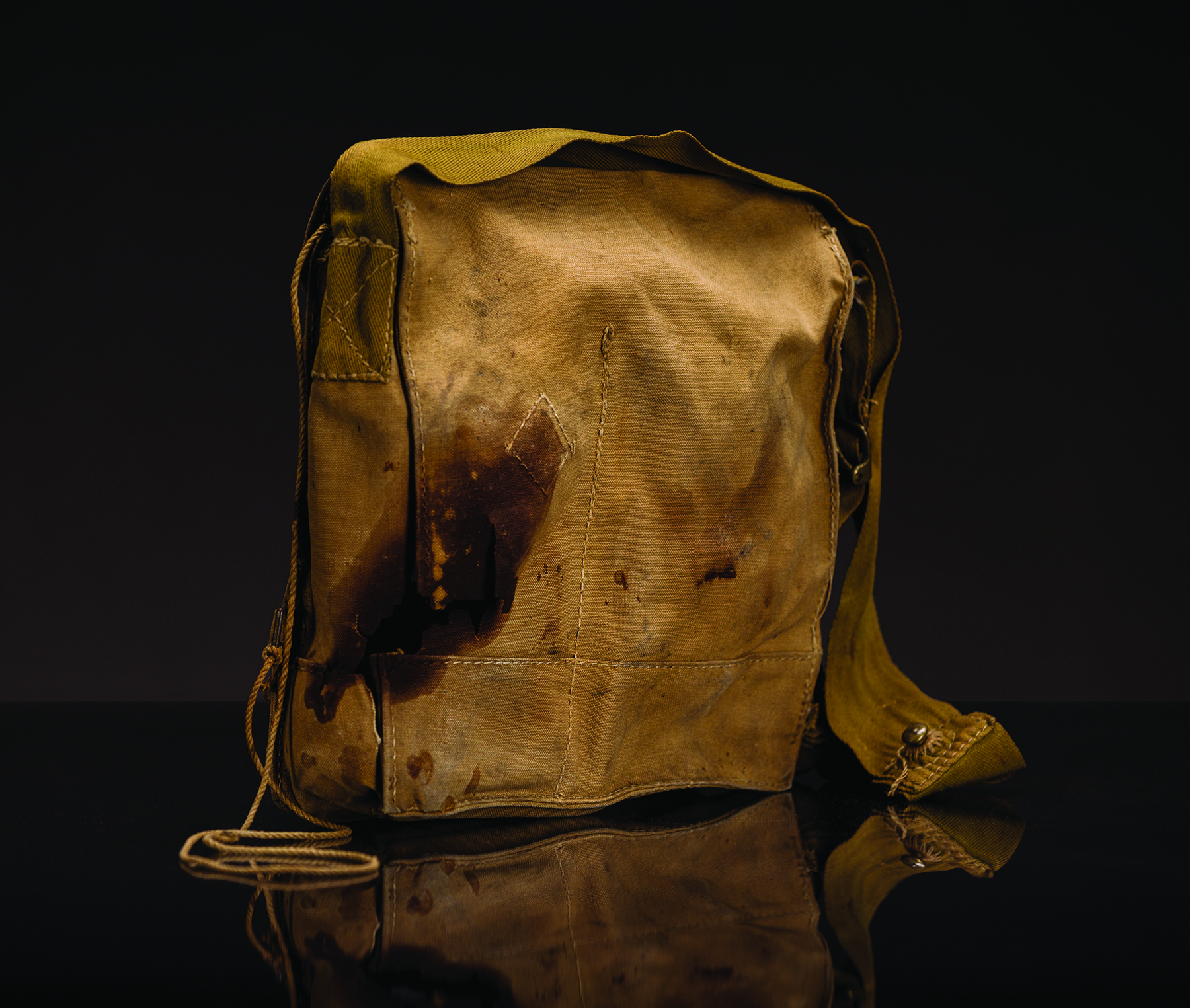
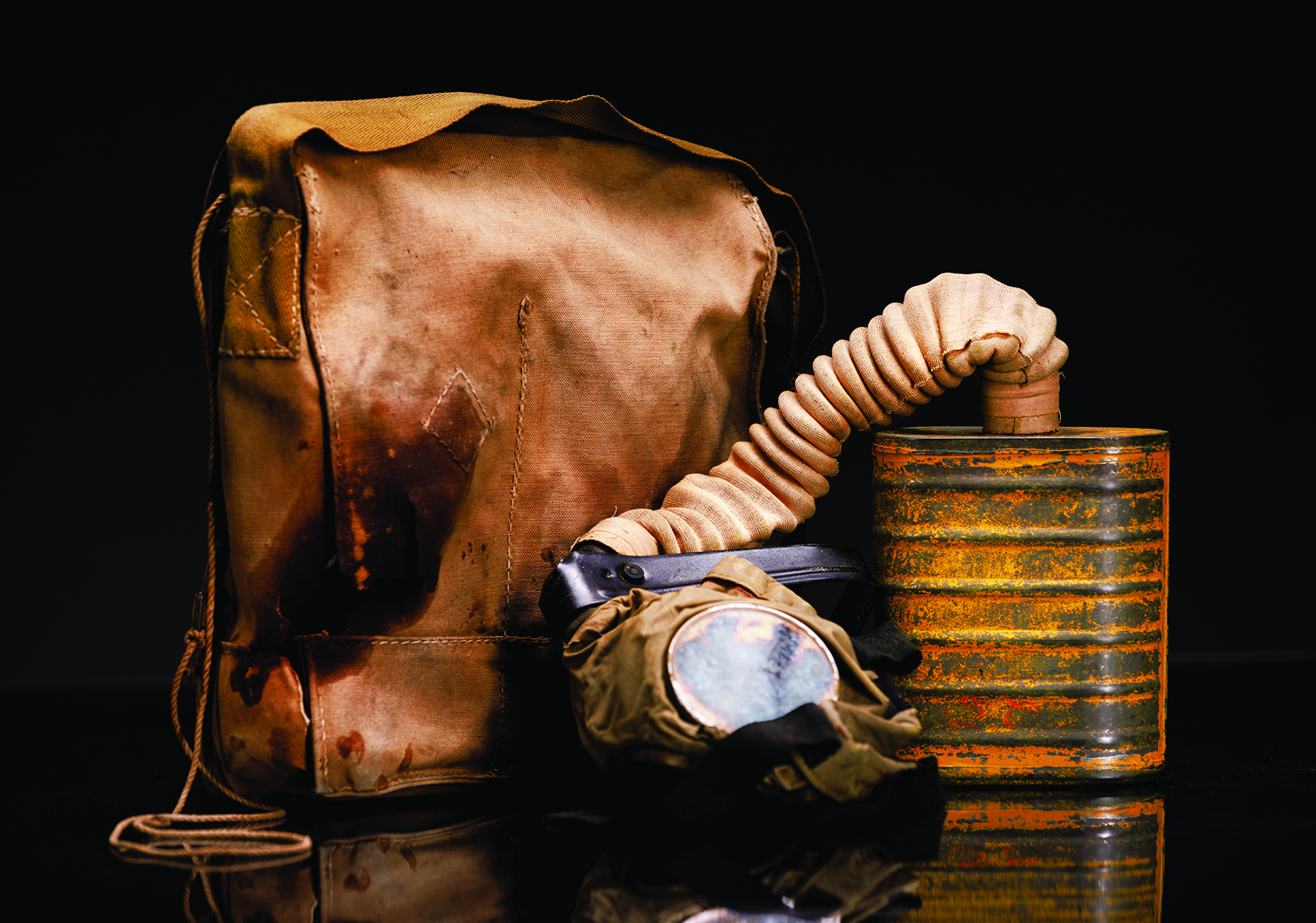
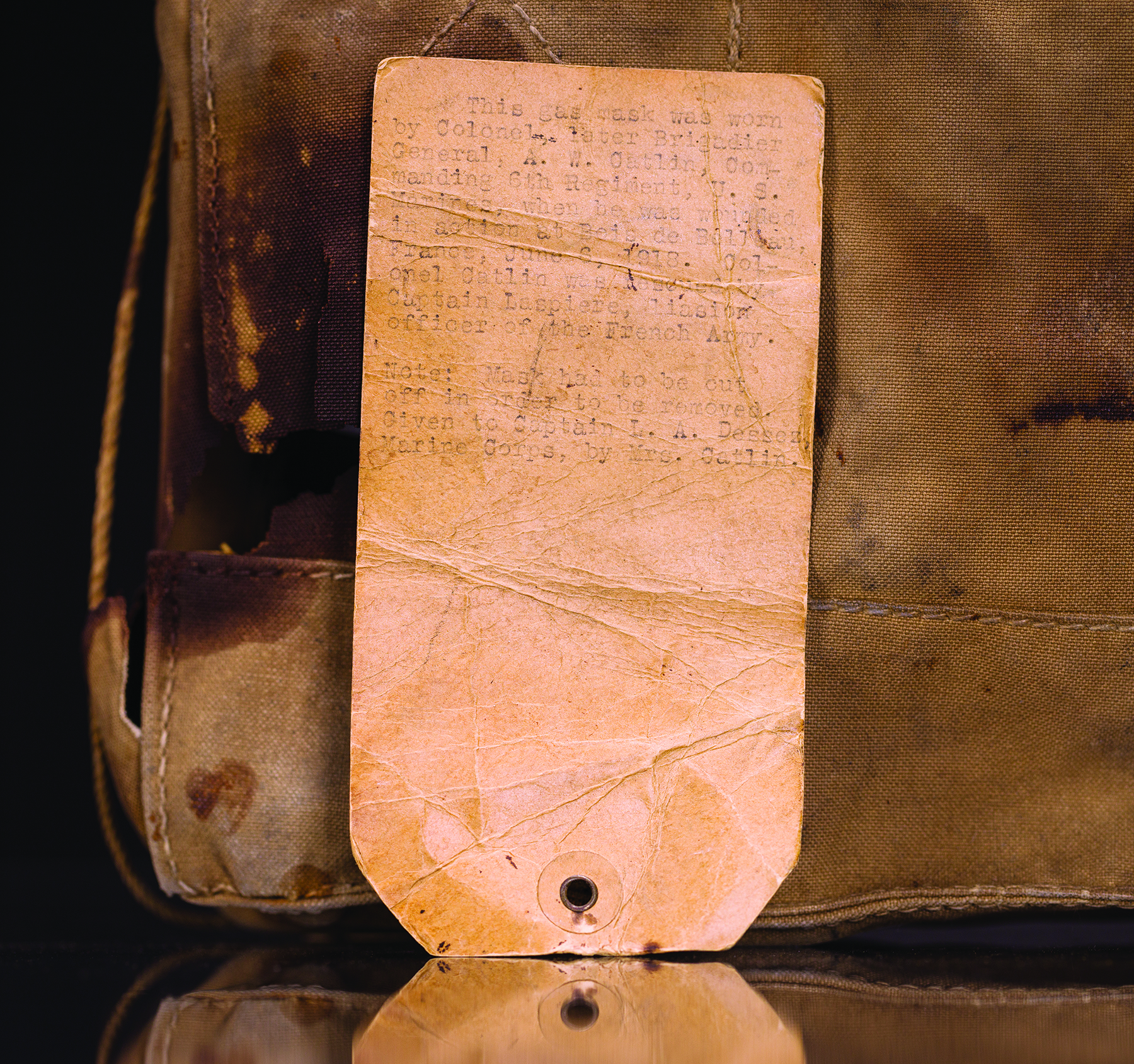
A carrier, gas mask, and M-1917, with gas mask bag tag donated to the National Museum of the Marine Corps.
Photos by Jose Esquilin, Marine Corps University Press.
This bloodstained gas mask carrier was worn by Colonel Catlin when he was severely wounded during the Battle of Belleau Wood. Catlin was shot in the chest; the bullet penetrated the bag, leaving it stained with his blood. The bag could have very well saved Catlin’s life.
A small paper tag, which accompanied the artifact when it was donated, describes Catlin’s wounding. It states, “This gas mask was worn by Colonel later Brigadier General A. W. Catlin, Commanding 6th Regiment, U.S. Marines, when wounded in action at Bois de Belleau, France, June 6, 1918. Colonel Catlin was rescued by Captain Laspiere, liaison officer of the French Army. Note: Mask had to be cut off to be removed. Given to Captain L. A. Dessez, Marine Corps, by Mrs. Catlin.”
Brigadier General Catlin’s other awards include, but are not limited to, the Purple Heart; the Sampson Medal; the West Indies, Philippine, and Haitian Campaign Medal; the Cuban Pacification Medal; the Mexican Service Medal; the Croix de Guerre with palm; and the Legion of Honour.
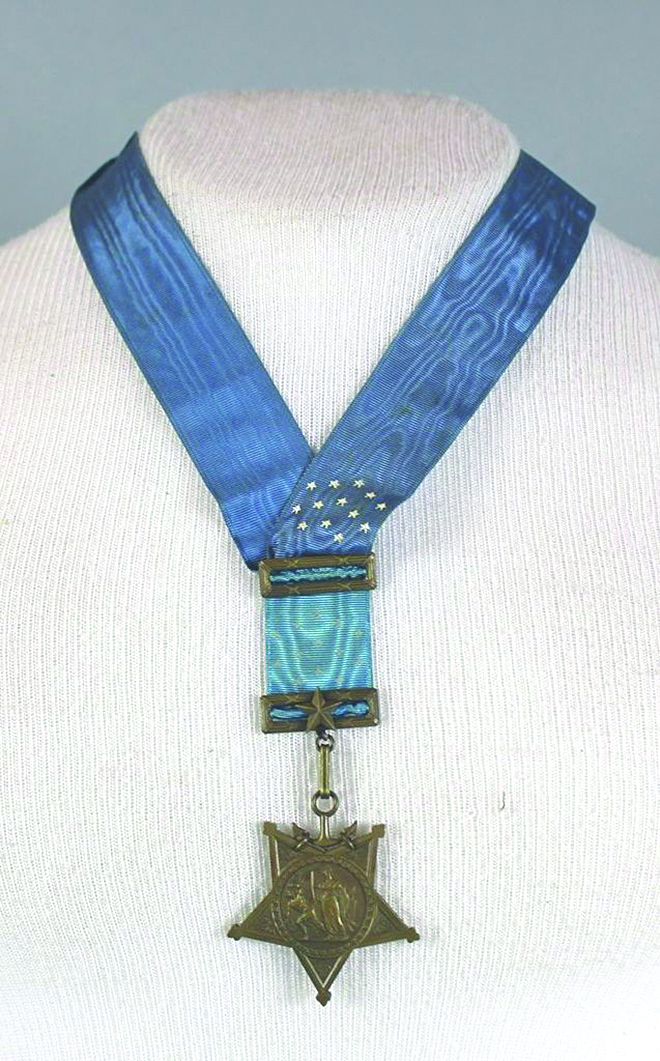
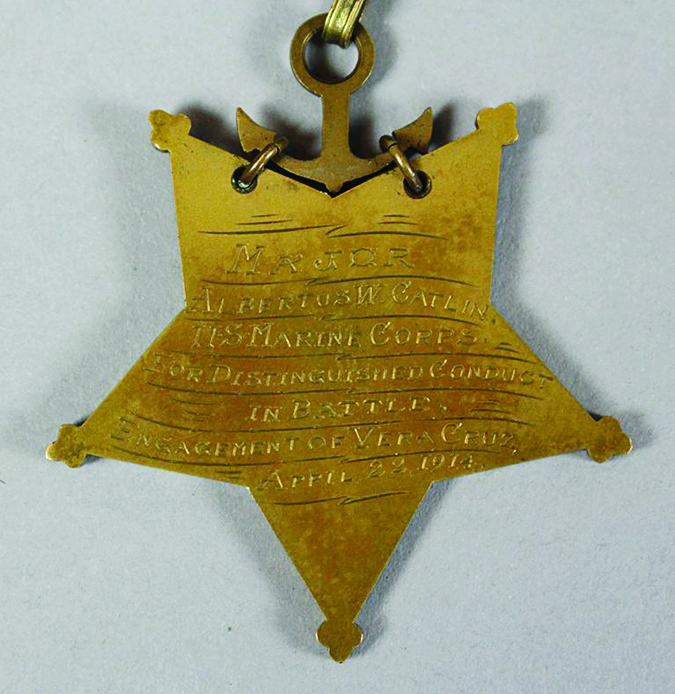
BGen Catlin’s Medal of Honor (front and back), with a custom neck band added by Catlin.
National Museum of the Marine Corps.
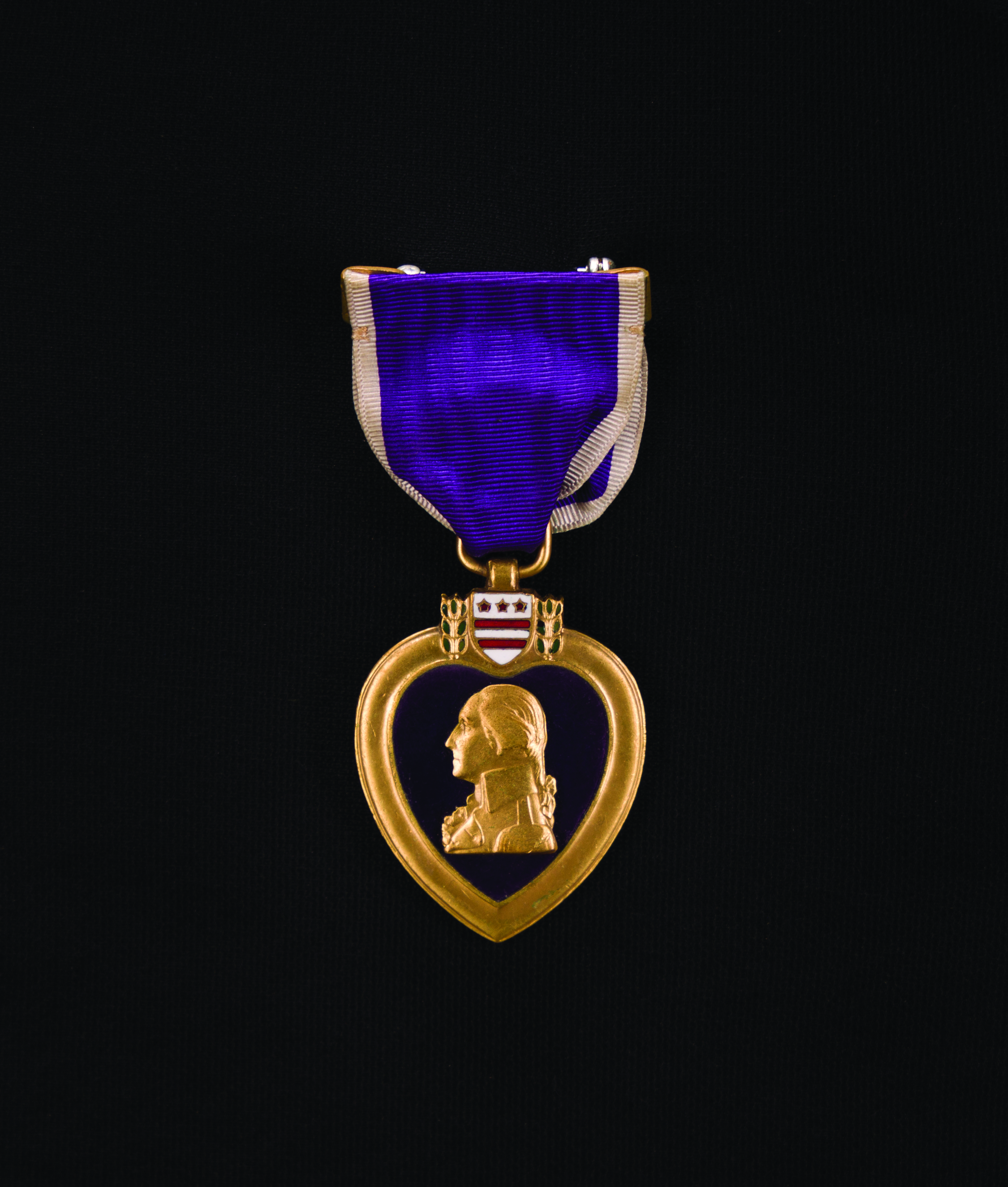
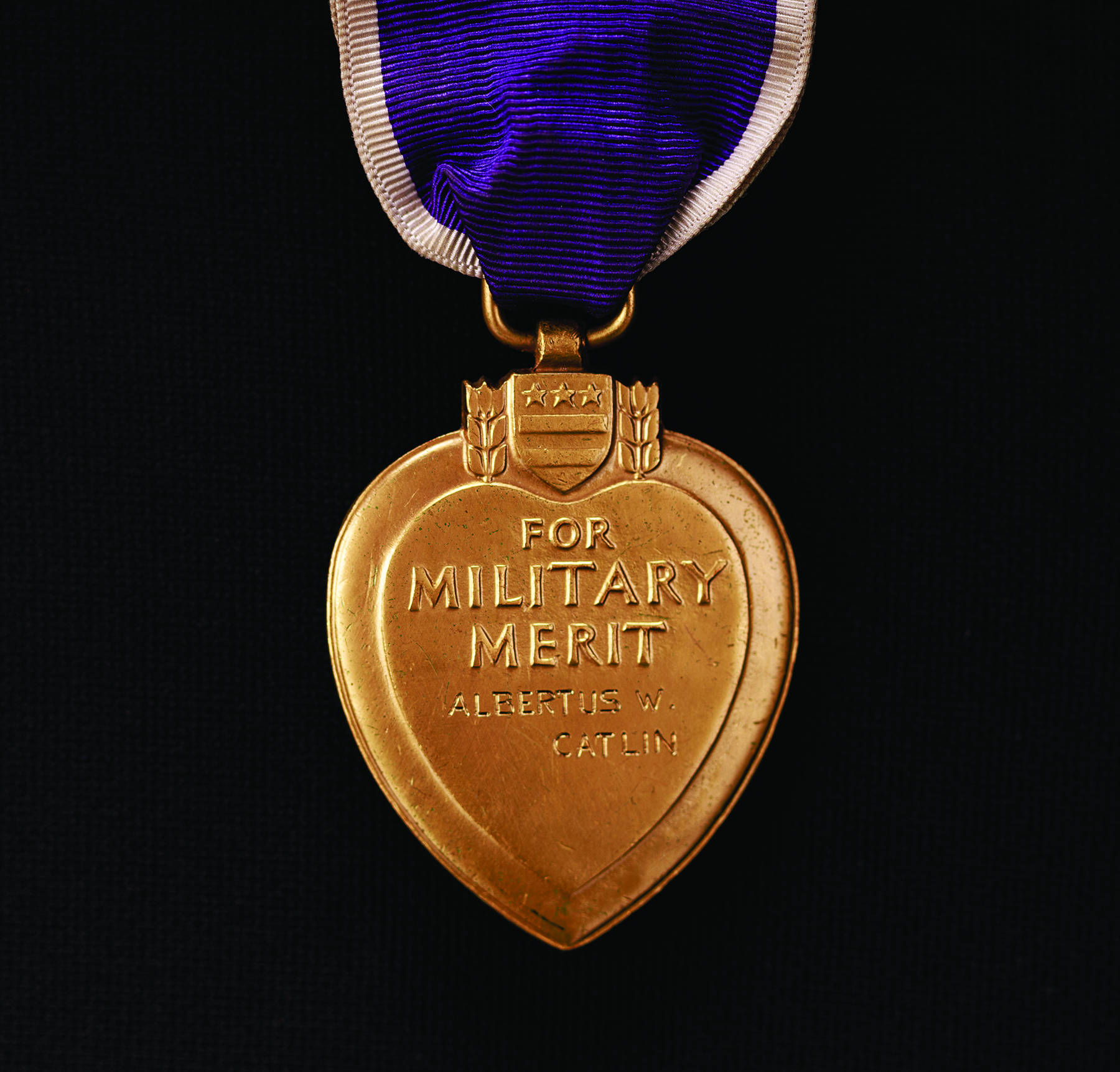
The Purple Heart medal (front and back) presented to Catlin in 1932 for wounds received at the Battle of Belleau Wood.
Photos by Jose Esquilin, Marine Corps University Press.
Endnotes
[1] BGen Albertus W. Catlin and Walter A. Dyer, With the Help of God and a Few Marines (Garden City, NY: Doubleday, 1919) 112.
[2] Annette D. Amerman, United States Marine Corps in the First World War: Anthology, Selected Bibliography, and Annotated Order of Battle (Quantico, VA: Marine Corps History Division, 2016).
[3] “USS Maine Memorial (Mast of the Maine),” Arlington National Cemetery, accessed 14 February 2024.
[4] Medal of Honor Citation, Albertus W. Catlin, 4 December 1915 (Marine Corps History Division, Quantico, VA).
[5] Catlin and Dyer, With the Help of God and a Few Marines, 112.
[6] Catlin and Dyer, With the Help of God and a Few Marines, 118.
[7] Catlin and Dyer, With the Help of God and a Few Marines, 119.
[8] Catlin and Dyer, With the Help of God and a Few Marines, 120–22.
[9] Bret Werner, Uniforms, Equipment, and Weapons of the American Expeditionary Forces in World War I (Atglen, PA: Schiffer, 2006).
[10] Alec S. Tulkoff, Equipping the Corps 1892–1937 (San Jose, CA: R. James Bender Publishing, 2010).